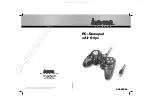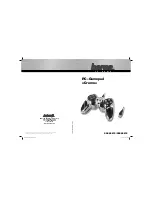
18
Actuator specifications must be sufficient for movement of the window without
encountering any obstacle. The limits indicated in the technical data table must not be
superseded
(page 16)
and the most appropriate stroke should be selected. Calculations
should be checked using the formula indicated on page 15.
Attention.
Check that the electrical power supply corresponds to that indicated on the
TECHNICAL DATA label on the machine.
Ensure that the actuator has not been damaged during transport, first visually and then by
powering in both directions.
Check that the width of the inside of the window (where the actuator is to be assembled)
is over 375 mm, otherwise the actuator should not be installed.
Check that once the actuator has been installed the distance
between the fixed part of the window frame (where the actuator
is to be assembled) and the mobile part of the window frame
(where the bracket is to be fixed) is greater than or equal to 0
mm (aside figure). If this is not the case the actuator will not
function correctly as the window will not close correctly. If
required, add additional thickness below the support brackets
to reset the quota.
For bottom hung window frames injury could be caused by accidental falls of the window.
An appropriately sized flexible link arm or fall prevention safety system designed to resist
a force equal to at least three times the total weight of the window MUST be installed.
8.1. Preparation of actuator for assembly
Before starting assembly of the actuator, prepare the following material for completion, equipment
and tools.
For fixing onto metal window frames: M5 threaded inserts
(6 pieces)
, M5x12 flat headed
metric screws
(6 pieces)
.
For fixing onto wooden window frames: self threading screws for wood Ø4.5
(6 pieces)
.
For fixing onto PVC window frames: self threading screws for metal Ø4.8
(6 pieces)
.
Equipment and tools: measuring tape, pencil, drill/screwdriver, set of drill heads for metal,
insert for screwing in, electricians pliers, screwdrivers.
8.2. Assembly for top hung windows, outward opening
Outward application
Figure 2
Figure 3
Figure 4
Figure 5
Figure 6
Above the drawing of specific application using accessories provided. For different
mountings, please contact manufacturer.
A. Trace centrepoint X in pencil onto the window frame (Fig.2).
B. Use brackets “A” and hinge “D”
(provided)
(Fig.3).
>=0
19
C. Apply the template onto the window frame (fixed part), taking care to ensure that the axis of the
template coincides with centrepoint X traced earlier (Fig.4).
Attention
: for non coplanar window
frames, cut the grey part of the template along the red line and apply onto the mobile part of the
window frame, taking care to keep it in the same reference position for the
X
axis.
D. Bore the window frame at the points indicated on the template (Fig.5).
E. Apply the brackets (A) to the window frame using flat head screws as indicated above. Check
both horizontal and vertical alignment of brackets.
F. Assemble the hinge for top hung windows (D) onto the mobile part of the window frame using
the reference points indicated on the template.
G. Complete assembly between chain terminal and quick hook using the Ø4x32 pin provided and
insert into central position (Fig.6).
H. Hook the actuator onto the brackets inserting the two channels at the end of the actuator into
the pins provided.
I. Rotate the actuator 90°, bring the chain terminal up to the hinge and insert the pin into the
channel of the latter. Connect the quick hook onto the bracket. At initial connection the hook will
present some resistance, this is normal as pieces need to adjust to their sockets.
J. Perform the electrical connections according to the diagram below or the label on the feeder cable.
K. Check that the output of the chain is perfectly aligned with the bracket. In the event that this
should not be the case, loosen the fixing screws and reposition the bracket correctly.
L. Perform a complete test of opening and closing of the window frame. After closure, check that
the window frame is completely closed and check pressure against the seals.
M. The stroke-end of the actuator during return is automatic. The appliance exerts traction to
guarantee perfect pressure against the seals.
8.3. Assembly for bottom hung windows
Inward application – transom window
Figure 7
Figure 8
Figure 9
Figure 10
Figure 11
Above the drawing of specific application using accessories provided. For different
mountings, please contact manufacturer.
a) Before starting works, at least two flexible mechanical link arms or other form of safety stops
MUST
be installed to guarantee hold and prevent accidental falling of the window in order to provide safe
working conditions.
b) Trace centrepoint X in pencil onto the window frame (Fig.7).
c) Use brackets “A” and hinge “C”
(provided)
(Fig.8).
d) Apply the template onto the window frame (fixed part), taking care to ensure that the axis of the
template coincides with centrepoint X traced earlier (Fig.9).
Attention:
for non coplanar window
frames, cut the grey part of the template along the green line and apply onto the mobile part of
the window frame, taking care to keep it in the same reference position for the X axis
.
e) Bore the casement at the points indicated on the template (Fig.10).

























